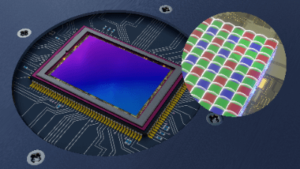What is CMOS Image Sensor?
Sony CMOS image sensors introduced the first commercial CMOS sensor in 1996 and have been at the forefront of digital image processing technology ever since. It has characteristics such as high sensitivity, high resolution, and low noise, and is widely used in digital products such as cameras and smartphones. Its innovative technology and quality have received high praise from manufacturers around the world, and it reigns as one of the top brands in the CMOS image sensor market.
- Strength of Sony CMOS Image Sensor
- Market Share
- Technical Trend
- Future
Strength of Sony CMOS Image Sensor

Sony’s CMOS image sensor is a highly regarded element in the digital imaging field, and its strengths are clearly visible in both technological innovation and market dominance. First of all, Sony’s CMOS image sensor provides high image quality. This is due to Sony’s proprietary technology, especially the Back-Illuminated Sensor (BSI) technology. This technology captures more light and provides better low-light performance than traditional sensors. Furthermore, Sony’s sensor has high color reproduction and can produce vivid and realistic images. Second, Sony’s CMOS image sensor offers fast readout speeds. This enables high-speed continuous shooting and high-resolution video recording, providing excellent performance when capturing fast-moving subjects such as sporting events and wildlife photography. Lastly, low power consumption is also great strength too. Sony’s sensor features an efficient power consumption design, contributing to longer battery life. This is especially important in applications such as portable devices and drones.
Market Share

Sony’s CMOS image sensor market share is said to be approximately 42% (Edge AI and Vision Alliance). This shows that Sony still holds a leadership position in the image sensor market.

Source: Edge AI+Vision
https://www.edge-ai-vision.com/2023/07/cmos-image-sensors-sony-is-still-leading-the-market/
Technical Trend

- Back side illumination technology (BSI)
- The back-illuminated sensor can capture light more efficiently than traditional sensors, greatly improving low-light shooting performance. Sony continues to innovate to further develop this technology and achieve higher image quality even with smaller pixels.
- Stacked CMOS sensor
- Stacked CMOS sensors place the image processing circuit directly below the pixel layer, improving data readout speed and enabling high-speed continuous shooting and high frame rate video shooting. Sony is using this technology to develop even faster image sensors.
- Global shutter
- Global shutter technology eliminates distortion during shooting (rolling shutter effect). This is especially important when photographing fast-moving subjects or when high-precision 3D mapping is required. Sony is focusing on developing sensors that use global shutter technology while maintaining high image quality.
- Integration of AI capabilities
- Sony is also focusing on integrating AI technology that performs image recognition and processing directly within the sensor. This allows devices to consume less power and provide benefits in terms of immediacy and security.
Future
The future of Sony’s CMOS image sensors has a brighter and more diverse outlook due to innovative technology and evolving market needs. Integration with AI will allow sensors to not only capture images, but also analyze and process data. This opens the way to new application areas such as self-driving cars, advanced security systems, and healthcare technology. Advances in stacked sensor and global shutter technology also enable faster shooting and distortion-free images, opening new possibilities for sports photography and filmmaking. Against the backdrop of these technological advances, Sony aims to contribute to a sustainable future by miniaturizing image sensors, improving energy efficiency, and promoting the development of portable devices and environmentally friendly products. Sony’s CMOS image sensors continue to improve in image quality, speed, and versatility and will be key to shaping the future of digital imaging.







